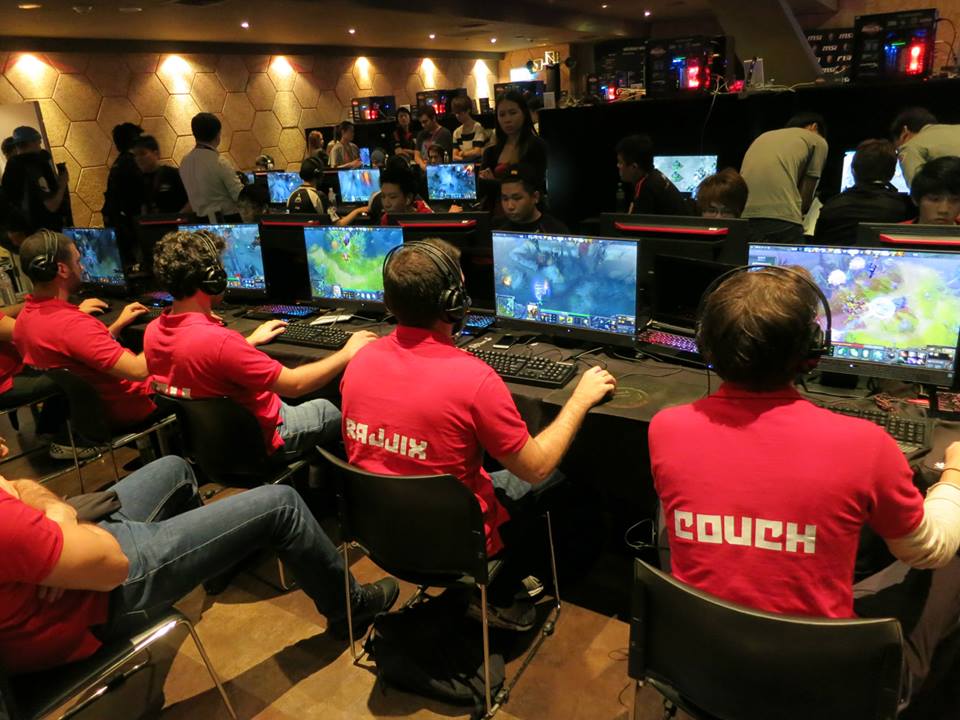MSI Beat It 2014 Dota 2 Grand Finals: Day 1 in review

Photo courtesy of MSI Gaming's Facebook page.
Large or small, top tier or bottom, every e-sports event begins the same way. At some point, the pyrotechnics and techno give way to the barely-manageable chaos of organising however many teams, however many matches, however many technical problems. As a journalist you can gauge how successfully an event is going by how quickly you bond with a stranger over the quest for working wi-fi.
Even by those standards, the first day of the MSI Beat It 2014 Grand Finals has been an experience. It started, honestly, a little rough – internet troubles on the community stages where the majority of Dota 2 matches were played, a lack of stream provision when Dota 2 was absent from the main stage, and, as you'd expect, spotty wi-fi. But through ad-hoc improvisation by the JoinDota guys and a quick response to the technical issues by MSI the event came together, and it's been an interesting twelve hours of Dota.
That's down to the roster of competitors. Beat It's continental qualifiers provided room for entrants from the Middle East, Africa, and Australia who you'd never normally see on the world stage. Unforeseen problems with Empire's availability and Arrow's match-fixing scandal resulted in Europe and SEA being represented by Virtus Pro and Insidious Idol respectively, and Na'Vi US and CDEC both represent the promise rather than the current pinnacle of their respective regions. Na'Vi US additionally played with three stand-ins, adding another degree of chance to an already chaotic line-up.
The result was a lot of scrappy, speculative Dota with moments of extraordinary coordination and collective skill. I watched the majority of the matches from the community stages, overcoming my wi-fi troubles by standing directly behind the players themselves. You get a decent sense for the character of a team when you hear the things they yell at each other. Mostly, it's "nice!". Often, "back!". Sometimes, sad silence.
At the time of writing the VODs aren't available, but when they are you'll find them here. You can, however, find stats pages and Match IDs on Dotabuff.
The beginning of the group stages
Keep up to date with the most important stories and the best deals, as picked by the PC Gamer team.
I figured that Na'Vi US would have Virtus Pro where they wanted them when they drafted Phantom Assassin against Faceless Void, but it didn't quite work out that way for either Na'Vi US or Phantom Assassin. A strong aggressive trilane built around VP.633's Mirana kept Na'Vi US on the back foot, and while they gained some ground during the midgame – particularly when they could take advantage of Ravage – they couldn't fight their way through VP's variously slippery or durable core heroes (nor the 150ms pings and 30% packet loss that affected both teams for extended stretches of the game.) They might have turned it around had it been a best of three, but it wasn't, and this was the start that both VP (and Faceless Void) needed in their long tournament run to follow.
Void showed up again in CDEC's roster when they faced Bravado Emotion, the winners of the African qualifier. Facing the tournament favourites in a best-of-one in their first match was a rough deal for Bravado, and the result was a very convincing win for CDEC – to the tune of 47 kills to 14.
It was a similar situation with APAC qualifier winners Rave and their first opponent, the Lebanese Wired Gaming. In a rare Void-free game, Wired picked up a bunch of strong cores – Ember Spirit, Viper, Batrider – but were utterly denied by an extraordinary Timbersaw performance by Rave.Chrissy. This was, for my money, unquestionably the best combination of player and hero at the event today.
Fear not! Faceless Void made a comforting reappearance with Immunity in their match against Insidious Idol, facing his sometime fling Invoker and 6.81 life partner Skywrath Mage. The game was dead even until around the 25 minute mark, when Immunity began to pull ahead thanks to the mobility and versatility of Weaver and Queen of Pain. Also, you know, Chronospheres. They finally broke base around the 56 minute mark, but went a little too HAM and lost four people – at the cost of most of Insidious' buybacks. Their answer, which I utterly respect, was to wait for their respawns and go HAM again, which won them the game.
Loser's best-of-ones
The losers of the first round were given a single shot to fight their way back in, and this led to some of the day's most heartbreaking games. Chief among them was Wired Gaming vs. Na'Vi US, a game that I know Na'Vi expected to win without too much of a problem. This overconfidence left them underprepared for a strong Templar Assassin performance by WG.Cbs, and the game was even until long past the point where Na'Vi's draft (with the exception of Morphling) had peaked. Then, Na'Vi secured a pick-off kill on Cbs just after he'd spent his buyback gold on the last parts of a Butterfly, and that gave them the foothold they needed to force a conclusion. Wired came very, very close.
Bravado Emotion faced Insidious Idol with the full compliment of Void, Skywrath Mage and Invoker, along with the (more popular than I thought, apparently) right-click carry Queen of Pain build. The structured play encouraged by the Chronosphere combo seemed to suit them, and they found sufficient form to win the game. The change in their attitude was palpable – of all the teams in the room, Bravado Emotion had (appropriately enough) the loudest and most emotive coaches. While watching the other concurrent matches I could more or less tell when Chronosphere was off cooldown by the cries of “YES BOYS” from across the room.
Winner's best-of-threes
Group A winners Virtus Pro and Rave were the first teams to face each other on the main stage, and VP quickly learned something that Wired had learned the hard way a few hours earlier: don't give Chrissy Timbersaw. Having lost game one as a consequence, VP came back in the second by focusing on the pickoff power of Nyx Assassin and (uhuh) Faceless Void. They couldn't quite pull off the Chain Frost-Chronosphere combo, however, calling their Lich draft into question – and by comparison, Rave's Centaur-Ancient Apparition-Sand King combination was very strong, and may well have constituted the best plays in the tournament. This earned ryo's Centaur the advantage he needed to give zero shits about anything that VP could throw at him, and crucially bought space for Jeyo's Medusa to farm. Given that this was a game with a Medusa in it, it ran very long – it takes time to attack-move through teamfights, man – but the energy picked up right at the end, when VP looked like they might just crawl back an advantage with several barracks down. They couldn't quite pull it together, however. Rave took the second game, and the set, thanks to all that space they won for Medusa.
CDEC's first game against Immunity lasted less than 24 minutes, with CDEC pulling out perfect games on maybe's Brewmaster and garder's Skywrath Mage. This match also saw Vengeful Spirit crop up as an effective counter to Batrider, a pick that has become more and more common and suggests that maybe – just maybe! - the bat might slip a few more places down the pick/ban list. I have to admit I missed CDEC's second win against Immunity because I stuck around to watch VP/Rave game two and was totally convinced that the game was about to end for about half an hour before it actually did. You know, because Medusa. Short version: Brewmaster is a very good hero, and CDEC – like Rave – took their second victory to secure a place in the semi-finals.
Loser's best-of-threes
The final games of the day were best-of-threes between the winners of the loser's best-of-ones and the losers of the winner's BO3s. This was, therefore, Na'Vi US' chance to get revenge on Virtus Pro and win a place in the semi-finals – and for a while, it seemed like they might do it. The combination of Korok's Necrophos and Demon's Elder Titan stymied VP's aggression for long enough to secure strong momentum, and another powerful Void performance sealed the deal. In game two, VP answered with an aggressive Wraith King/Vengeful Spirit/Ancient Apparition trilane that successfully controlled Na'Vi's safelane Void, and while Na'Vi managed a few impressive pickoffs with the global combo of Korok's Zeus and Demon's Nature's Prophet they found themselves needing control, not nuking power. Na'Vi's play got shakier as the game continued, while VP found form and forced a third.
Vengeful Spirit and Void made reappearances for VP in the third game, along with a clowny-but-effective Magnus performance by VP.G that involved a lot of cancelled Reverse Polarities for some reason. VP also continued their use of Gyrocopter as a complement to an offlane Void, and while Na'Vi US were able to find trades throughout the game thanks to Ember Spirit and Doom it wasn't ultimately enough to stop a slow shift of power to VP. In the tournament as a whole, VP have shown the most discipline when it comes to securing Roshan whenever he spawns and making full use of the momentum their teamfight victories grant them. Where other teams seemed to rely on individual moments of flare to find an advantage, VP's map control came almost entirely from constant, sustainable pressure – ironically, exactly what Na'Vi used against them in the first game. By the third game the (constant, sustainable) shoe was on the other foot, and VP reclaimed their spot at the winner's table.
What was striking about Bravado Emotion vs. Immunity was how similar the games were, structurally, to the Na'Vi/VP match that ran concurrent with it. In both sets, the first game ran close to an hour and was won by the team most able to control the pace of the game – in this case, Bravado, with their Brewmaster and Timbersaw creating the space for Anti-Mage to farm. Likewise, the second game was short thanks to a return salvo of aggression as Immunity drafted for the early game – Windrunner, Witch Doctor, Ogre Magi, Mirana, Centaur – and secured a kill advantage that Bravado just couldn't come back from. By the third game, the last of the night, Bravado seemed exhausted. They picked up the Brewmaster again, but didn't take advantage of the momentum that comes with using Primal Split to threaten the enemy around the map. Immunity claimed an early kill and tower advantage and Bravado were left defending against mega creeps for an agonisingly long stretch right at the end of the game. Facing elimination they refused to GG, successfully repelling attack after attack while Immunity were happy to sit outside, let creeps do the work, and take Roshan when it was available. Bravado even managed to claim a kill advantage by the end - but they couldn't claim map control to match it, and their end was slow and hard to watch. They should, nonetheless, be proud of how far they got – as should Immunity, for staying in control after a very trying day of play.
Virtus Pro, CDEC, Rave and Immunity face off in the semi-finals tomorrow.
Joining in 2011, Chris made his start with PC Gamer turning beautiful trees into magazines, first as a writer and later as deputy editor. Once PCG's reluctant MMO champion , his discovery of Dota 2 in 2012 led him to much darker, stranger places. In 2015, Chris became the editor of PC Gamer Pro, overseeing our online coverage of competitive gaming and esports. He left in 2017, and can be now found making games and recording the Crate & Crowbar podcast.


